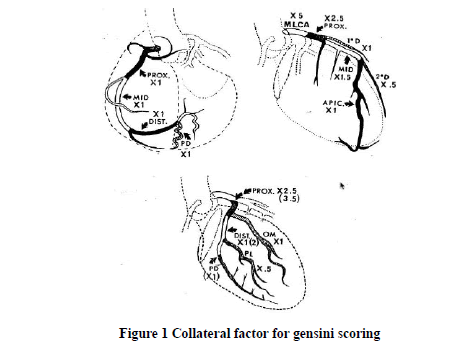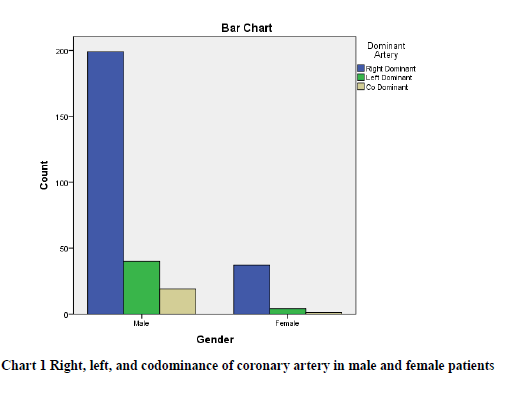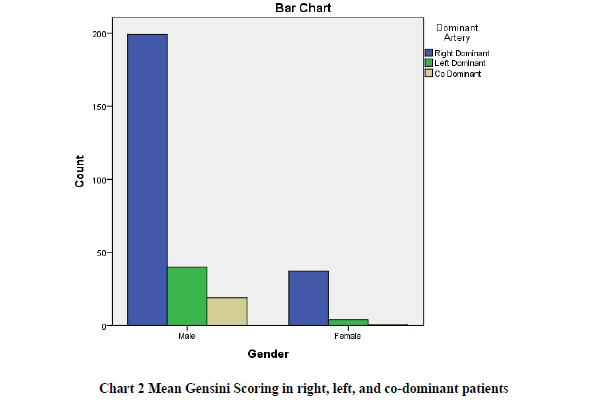Research - International Journal of Medical Research & Health Sciences ( 2021) Volume 10, Issue 5
Frequency of Coronary Artery Dominance in Patients at Single Center in Lahore
Ammara Ghafoor1, Nadia Ahmad1*, Saeed Afridi2, Adnan Khan1 and Nausheen Raza12Department of Cardiac Surgery, Sharif Medical and Dental College, Lahore, Pakistan
Nadia Ahmad, Department of Anatomy, Sharif Medical and Dental College, Lahore, Pakistan, Email: diaejaz_74@hotmail.com
Abstract
Objectives: 1. Aims to find out the frequency of coronary artery dominance incidence by the angiographic method. 2. Association of coronary artery dominance with coronary artery disease through Gensini scoring.
Design: Retrospective record review.
Setting: Single-center, retrospective record review carried out in Sharif Medical and Dental College, Lahore, on 300 patients who underwent coronary angiography during 2018-2019.
Methods: Patients were categorized as right (Rt D), left (Lt D) and co-dominant (Co D) based on the dominance pattern reported on coronary angiograms.
Results: From a total of 300 patients, 258 (86%) were male and 42 (14%) were female with a mean age of 55.59 ± 9.18 years. The majority of the patients had a right dominant coronary artery system 236 (78.7%) whereas left and co-dominance were 44 (14.7%) and 20 (6.7%) respectively. When assessed through the Post Hoc Tukey test the Gensini scoring in the left dominant patients was observed to be significantly higher 83.64 ± 15.282 as compared to the right and co-dominant which were 72.73 ± 24.998 and 73.40 ± 26.589 respectively.
Conclusion: The right coronary artery dominant pattern is more prevalent in our population as compared to left and co dominancy with age and gender have no association. However, the frequency of coronary artery stenosis is much higher in the left dominant pattern as observed through the Gensini scoring system.
Keywords
Coronary artery, Right dominance, Left dominance, Coronary angiography, Gensini scoring
Introduction
The word coronary comes from the Latin word corona, meaning the crown-like distribution of all the arteries around the heart [1,2]. In 1904, for the first time Banchi described coronary circulation [3].
Knowledge of the anatomy of coronary arteries and their branches is important clinically in the management of cardiac diseases and associated complications [4]. The heart is supplied by the right and left coronary arteries which arise from anterior and left posterior sinuses of the ascending aorta, respectively. These two arteries form an anastomotic circle in the atrioventricular groove which is connected by marginal and interventricular (descending) loops intersecting at the apex of the heart. There is insignificant variation in the degree of anastomosis of these vessels [5]. Later on, Hettler classified coronary artery dominance as right, left, and co-dominant [3]. When the Posterior Descending Artery (PDA) fills from the Right Coronary Artery (RCA), it is called right dominance, which is common in 87%-89% of the population. When PDA fills from the Left Coronary Artery (LCA), it is called left dominance, which is prevalent in 7%-8% population. In co-dominance, PDA fills from both the right and left coronary artery which exists in 4% of the population [4,6]. Another dominance pattern is based on the origin of the Sino-Atrial (SA) nodal branch from the right or left coronary artery characterizing the coronary dominance [7]. Wide variation exists in coronary artery dominance patterns among different populations [1]. Morbidity and mortality rates are much higher because of the increasing worldwide incidence of various heart diseases more so in the developed countries [8].
Gensini scoring system emphasizes the coronary artery disease severity and the functional importance of the area of the lesion [9]. The anatomical knowledge regarding variations will help understand the cardiovascular disease severity and its management [4]. Therefore, the present study was designed to see the variance in coronary artery dominance pattern and its relation to the disease severity as assessed through Gensini scoring in the local population.
Literature Review
Study Population
It was a retrospective record review conducted on 300 coronary artery angiographies carried out in Sharif Medical and Dental College, Lahore (2018-2019). Coronary angiograms were read from adult patients of all age groups from both genders having standard indication for Coronary Angiography (CAG). Patient records were de-identified and anonymized before analysis.
Exclusion Criteria
Pregnant females and patients with incomplete CAG records were excluded from the study group.
Patient and Public Involvement
We did not involve the patients in the current study nor did we disseminate the results to the patients.
Operational Definition
Right dominance: When PDA fills from the right coronary artery.
Left dominance: When PDA fills from the left coronary artery.
Co dominance: When PDA fills from both the right and left coronary artery.
Gensini scoring: It accounts for quantifying angiographic narrowing of coronary arteries along with their location.
Data Measurement
All coronary angiographies were done by using a standard procedure through radial or femoral artery [10,11]. The coronary angiogram reporting was written and confirmed by interventional cardiologists.
The dominant artery was determined by observing the filling of the posterior descending artery from a left coronary artery or right coronary artery. Right dominance was labeled when the right coronary artery filled the PDA and left dominance was defined when the PDA was filled up by the left coronary artery. Co dominance was labeled when PDA was filled up by both the right and left coronary arteries [12].
The location and degree of coronary artery narrowing were evaluated through the Gensini scoring system. In this scoring system 0 indicates no abnormality and stenosis is represented by, 1 (1% to 25%), 2 (26% to 50%), 4 (51% to 75%), 16 (76% to 99%), and 32 (100% or complete occlusion). Then the score is multiplied by different factors like region multiplying factors for coronary segments, according to the functional significance of the coronary artery (Figure 1, Table 1) [13].
Statistical Analysis
| Reopacified and Normal | 32 × 0.5 | 16 |
| Reopacified and 25% or S | 32 × 0.5 × 1/4 | 12 |
| Reopacified and 50% or S | 32 × 0.5 × 1/2 | 8 |
| Reopacified and 75% | 32 × 0.5 × 1/4 | 4 |
| Reopacified and 90% | 32 × 0.5 × 1/8 | 2 |
| Reopacified and 99% | 32 × 0.5 × 1/16 | 1 |
| If 99% receiving collateral | 16 × 0.5 | 0 |
Table 1: Gensini score calculation
The collected data were entered into the computer software Statistical Package for Social Sciences (IBM SPSS Version 23) and analyzed through it. Mean ± SD (Standard Deviation) is given for quantitative variables. Frequencies and percentages are given for qualitative variables. Graphs are presented for both qualitative and quantitative variables. Pearson’s Chi-Square test was applied to observe associations between qualitative variables. One-way ANOVA was applied to compare the mean between groups. Post-Hoc Tukey test was applied to observe which groups mean differs. A p-value of <0.05 was considered statistically significant.
Results
This study included coronary angiograms of 300 patients of which 258 (86%) were male and 42 (14%) were female. The mean age of patients was 55.59 ± 9.18 years. The results of coronary artery angiograms showed that 236 (78.7%) were right dominant, 44 (14.7%) were left dominant and 20 (6.7%) were co-dominant. In the males, right dominance was found in 199 (77%), left dominance was observed in 40 (15.5%) and codominance was observed in 19 (0.07%) out of 258 patients. In the females 37 (88%) were right dominant, 4 (0.09%) were left and 1 (0.02%) was co-dominant out of a total of 42 patients (Chart 1). Pearson chi-square test showed no association between gender and dominance of coronary artery. The mean Gensini score of 300 patients was 74.38 ± 24.18. The mean Gensini scoring in right dominant patients was found to be 72.73 ± 24.998 and in co-dominant patients was 73.40 ± 26.589 (Chart 2). However, the Gensini scoring in left dominant patients was much higher and was observed to be 83.64 ± 15.282. Analysis of Variance (ANOVA) showed that there is a significant association between Gensini scoring and coronary dominance (Table 2). We applied the Post Hoc Tukey test that showed coronary artery stenosis is significantly higher in the left dominant coronary artery system as compared to the right and co-dominant groups (p-value 0.006) (Table 3).
| Gensini Scoring | Sum of Squares | df | Mean Square | F | Sig. |
|---|---|---|---|---|---|
| Between Groups | 4429.273 | 2 | 2214.636 | 3.862 | 0.022 |
| Within Groups | 170325.2 | 297 | 573.485 | ||
| Total | 174754.4 | 299 |
Table 2: ANOVA between groups and within groups of mean Gensini Scoring in right, left, and co-dominant patients
| Dominant Artery | Dominant Artery | Mean Difference | Std. Error | Sig. |
|---|---|---|---|---|
| Right Dominant | Left Dominant | -10.903* | 3.932 | 0.006 |
| Right Dominant | Co Dominant | -0.667 | 5.577 | 0.905 |
| Left Dominant | Co Dominant | 10.236 | 6.458 | 0.114 |
*: Statistically significant
Table 3:Post Hoc Tukey test showing coronary artery stenosis is significantly higher in the left dominant coronary artery system as compared to the right and co-dominant groups
Discussion
The dominance pattern of the coronary artery of the heart has vital clinical significance. Coronary circulation is defined as Rt D, Lt D, and Co D based on filling of the posterior descending artery using coronary artery angiogram. Cardiovascular outcomes are associated with coronary artery dominance [14]. In the current study, we found that Lt D was associated with the severity of coronary artery disease as indicated by the Gensini scoring.
In the current study, the right dominance was observed to be 78.7%, left dominance 14.7% and 6.7% were co-dominant. Our results were comparable to previous studies carried by Ersin, et al. [13].
No significant difference was in dominance pattern was found with the gender. Our results were from the study carried out by Fazlul Aziz Main, et al. [15]. The Gensini scoring system is a quick and easy tool to quantify the severity of coronary artery disease in clinical settings. Therefore, we used this scoring system to further investigate the association between coronary dominance and CAD. In the present study, the total Gensini score of Lt D patient was significantly higher than a patient with Rt D and Co D. Although in our study the right dominant circulation was 78.7% coronary artery disease was more severe in the left dominant group. There was no difference between co-dominant and right dominant when compared with coronary artery disease. Our study correlates with the previous study carried out by Fazlul, et al., and Erens, et al. [15,16].
Conclusion
The current study showed that the incidence of right coronary artery dominance is higher in our population and patients with left coronary artery dominance had a significantly higher proportion of coronary artery disease than patients with Rt and Co D groups. No significant association of coronary artery dominance was observed with age and gender.
In the future, this study can be improved by increasing the number of patients from different medical centers and taking a detailed examination and investigations, and correlating with the coronary artery angiograms. These results will help us in determining the risk factors and severity of coronary artery diseases prevalent in our part of the world.
Limitations
This study has some limitations as it was conducted in a single center with a relatively smaller number of patients and most of them were males. Also, the study conducted was a retrospective record review with no data of medical history and investigations.
Declarations
Conflicts of Interest
The authors declared no potential conflicts of interest concerning the research, authorship, and/or publication of this article.
Acknowledgments
We are especially thankful to Dr. Kashif Zafar and Dr. Qazi M. Tufail for performing cardiac angiographies and sharing the data for this study.
Disclosure
There has been no disclosure.
Source of Funding
This research did not receive any specific grant from funding agencies in the public, commercial, or not-for-profit sectors.
References
- Das,, Hirak, et al. "A study of coronary dominance in the population of Assam."Journal of Anatomical Society of India,Vol. 59, No. 2, 2010, pp. 187-91.
- Moore, K. L., A. F. DalleyII, and A. M. R. Agur. "Clinically Oriented Anatomy, 7th EditionMD." Clinical Anatomy, 2014.
- Ghaffari, Samad, et al. "The relation between left coronary dominancy and atherosclerotic involvement of left anterior descending artery origin."Journal of Cardiovascular and Thoracic Research,Vol. 5, No. 1, 2013 pp. 1-4.
- Gawlikowska-Sroka, A., D. Miklaszewska, and F. Czerwinski. "Analysis of the influence of heart size and gender on coronary circulation type."Folia Morphologica,Vol. 69, No. 1, 2010, pp. 35-41.
- Gray, Henry, and Susan Standring."Gray's anatomy: The anatomical basis of clinical practice." Churchill Livingstone, 2008.
- Gorlin, R. "Coronary anatomy."Major Problems in Internal Medicine,Vol. 11, 1976, pp. 40-58.
- Darmender, Puli, Seema Madan, and Takkallapalli Anitha. "A study of coronary artery predominance and its clinical importance."IOSR Journal of Dental and Medical Sciences,Vol. 1, No. 13, 2014, pp. 36-38.
- Meshram, SW. "The study of coronary artery dominance and its clinical significance in Central India population." Indian Journal of Applied Research, Vol. 8, No. 3, 2018, pp. 5-7
- Kashani, Homa, et al. "Analyzing Gensini score as a semi-continuous outcome."The Journal of Tehran University Heart Center,Vol. 11, No. 2, 2016, pp. 55-61.
- Peng, Liyuan, et al. "Impact of right coronary dominance on triple-vessel coronary artery disease: A cross-sectional study."Medicine,Vol. 97, No. 32, 2018, pp.1-5.
- Levine, Glenn N., et al. "2011 ACCF/AHA/SCAI guideline for percutaneous coronary intervention: A report of the American College of Cardiology Foundation/American Heart Association Task Force on Practice Guidelines and the Society for Cardiovascular Angiography and Interventions."Circulation, Vol. 124, No. 23, 2011, pp. e574-e651.
- Pelter, Michele M., Salah S. Al-Zaiti, and Mary G. Carey. "Coronary artery dominance."American Journal of Critical Care,Vol. 20, No. 5, 2011, pp. 401-02.
- Knudtson, Merril. "Coronary scoring systems."A Historical Perspective,2014.
- Ozturk, Ersin, et al. "Arterial supply of the posterior interventricular sulcus: A CT coronary angiographic study."Surgical and Radiologic Anatomy,Vol. 33, No. 1, 2011, pp. 27-34.
- Rehman, Mehboobur, et al. "Coronary Artery Dominance: What pattern exists in Pakistani Population?"Annals of Pakistan Institute of Medical Sciences,Vol. 7, No. 1, 2011, pp. 3-5.
- Eren, Suat, et al. "An investigation of the association between coronary artery dominance and coronary artery variations with coronary arterial disease by multidetector computed tomographic coronary angiography."Journal of Computer Assisted Tomography,Vol. 32, No. 6, 2008, pp. 929-933.



